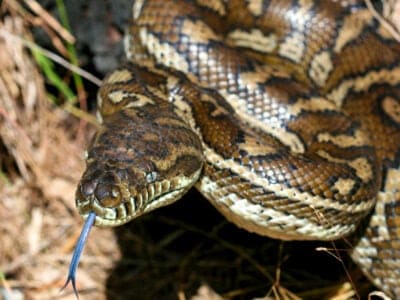Pied Ball Python
.jumbotron {
background-image: url(“https://a-z-animals.com/media/2022/02/shutterstock_193605035-400×300.jpg”);
}
}
@media only screen and (min-width: 641px) and (max-width: 920px) {
.jumbotron {
background-image: url(“https://a-z-animals.com/media/2022/02/shutterstock_193605035-470×370.jpg”);
}
}
@media only screen and (min-width: 921px) {
.jumbotron {
background-image: url(“https://a-z-animals.com/media/2022/02/shutterstock_193605035.jpg”);
}
}
Pied Ball Python
Python regius
Pied Ball Python Facts
This post may contain affiliate links to our partners like Chewy, Amazon, and others. Purchasing through these helps us further the A-Z Animals mission to educate about the world’s species..

Spiders that fly! Fish that walk! And 1000+ more incredible animals. Discover them all for FREE
.photo-gallery {
–margin: 0px auto 0px;
–padding: 0px 0px 0px 0px;
}
.gallery-link {
background-image: url(“https://a-z-animals.com/media/2022/02/shutterstock_193605035-1024×535.jpg”);
background-repeat: no-repeat;
background-size: cover;
background-position: center;
height: 500px;
justify-content: center;
text-align: center;
align-items: center;
display: flex;
border: 2px solid #000;
}
.gallery-link img {
height: 50%;
}
@media only screen and (max-width: 768px) {
.gallery-link {
height: 300px !important;
}
}
View all of the Pied Ball Python images!
Pied Ball Python Summary
The pied ball python is a unique color morph of the standard ball python.
The pied color morph is extremely rare in the wild, but it is becoming increasingly popular in the pet trade. The piebald pattern, which appears in other animals like horses and dogs, is characterized by white patches surrounding the otherwise dark skin. This is just one of many possible exotic color morphs of the ball python, along with Oreo, pastel, banana, and others. Ball pythons are considered to be easy to care for whether you’re a novice or expert snake owner, but this particular color morph has a very high upfront price that may deter all but the most dedicated owners.
5 Pied Ball Python Amazing Facts
- The ball python’s annual reproductive season usually takes place between September and November, but it’s also possible to breed them all year-round. The mother will produce a clutch of up to 14 eggs that stick to each other with an adhesive. She will coil around the clutch until the eggs are ready to hatch about a month or two later. The males do not seem to play any role in the care or development of the offspring.
- Ball pythons tend to have an average lifespan of about 10 years in the wild and some 20 years in captivity. However, one specimen from the Philadelphia Zoo supposedly lived some 50 years old.
- Ball pythons have five labial pits on either side of the mouth to sense heat or infrared radiation. This helps them find food when it becomes dark out.
- While they spend most of their time on the ground, ball pythons are also decent climbers and excellent swimmers.
- Males have large spurs on both sides of the body to grip the female during sex. Females have these spurs too, but they are smaller.
Where to Find Pied Ball Pythons
In the wild, ball pythons are found in grasslands, savannas, and sparse woodlands throughout West Africa, from the Atlantic coast almost to Lake Victoria. In the wild, ball pythons spend much of the day in underground burrows. They are most active at dawn and dusk to hunt for prey.
Pied Ball Python Scientific Name
The scientific name of the ball python is Python regius. The word Python derives from the Greek name of a huge mythological serpent killed by Apollo, whereas Regius means royal or kingly in Latin. This species is closely related to the Indian python and the African rock python in the same genus.
Pied Ball Python Population & Conservation Status
According to the IUCN Red List, the ball python is near threatened in the wild due to habitat loss and poaching. There isn’t enough information about this species to make any population estimates, but numbers do appear to be decreasing across much of its natural range. The pied color morph in particular is very rare in the wild and usually the result of a random mutation that quickly dies out or becomes diluted, but it was carefully bred in captivity to create more of them for the pet trade.
How to Identify Pied Ball Pythons: Appearance and Description
Most ball pythons are characterized by black or dark brown skin with irregular light brown blotches or stripes running along the back and sides. Pied color morphs mostly have this same pattern but with the addition of large white patches of varying size all over the body. Some individuals are almost completely white with only a few brown patches instead. The piebald morph is caused by a “recessive” trait (meaning the snake must inherit the trait from both parents) that creates white non-pigmented patches along their skin. In addition to the “regular” pied ball python, there are also pied versions of the banana, pastel, and Oreo python too.
Apart from the unique skin color, they look almost exactly like any other ball python. They have large, thick bodies, measuring somewhere between 3 and 6 feet long and up to 5.5 pounds in weight, with triangle-shaped heads. Adult females tend to be slightly larger than adult males, but otherwise the sexes are difficult to tell apart without a very thorough examination.
Here is how to identify the pied ball python:
- Light brown blotches or stripes against a dark brown or black background
- Large white patches all over the body
- 3 to 6 feet in length
- Triangle-shaped head
Pied Ball Python: How Dangerous Are They?
Ball pythons are not very dangerous to humans at all. They are non-venomous snakes that hunt for prey entirely through constriction. A bite may cause pain, swelling, and redness, but otherwise it poses no significant danger or long term complications. Adult pythons are near the top of the food chain. They have few natural predators in the wild, but they may seek cover or rely on their camouflage if threatened. Younger pythons may be preyed upon by carnivorous mammals and large birds.
Pied Ball Python Behavior and Humans
Because ball pythons lack sharp fangs and venom, they do not generally attempt to bite people except out of self-defense. When threatened, this snake will roll up into a ball (hence the name) with their head and neck tucked away in the middle of the pile. Their fairly non-aggressive temperament can actually make them quite easy to handle in captivity, provided they have grown used to your presence. However, there are limits to how much you can interact with the snake. They should not be handled while shedding their skin, because they are particularly sensitive at this time. They should not be fed by hand either, because they can accidentally bite. And ball pythons should never be approached in the wild, because they may attempt to fight back.
In captivity, a pet ball python has several special considerations for its care. The snake will need at least a 60-gallon tank longer than it is tall. This tank should be filled with soil or wood shavings, a water dish for drinking and soaking, and plenty of logs and other hiding places. The temperature should be set to 80 to 85 degrees Fahrenheit during the day with a basking spot up to 90 degrees. Full spectrum lighting should be used to mimic its natural conditions, but an UVB lamp hasn’t proven to be necessary. The humidity should be set to around 55% to 60% to create a comfortable environment for your snake. Depending on their size, an adult snake will need to be fed a large freshly dead or thawed rat or mice once every two to four weeks. Keep in mind they can be a little picky about the freshness of their food. The snake may reject older food that’s been sitting out too long.
View all 117 animals that start with P
Pied Ball Python FAQs (Frequently Asked Questions)
Are pied ball pythons venomous?
Ball pythons do not have the ability to produce venom.
How do pied ball pythons hunt?
Ball pythons are “sit and wait” ambush predators. After rapidly striking out at their prey, they will attempt to constrict it to death. This means their bodies will wrap around the prey and cut off blood flow until it dies. They may also swallow the prey alive too.
Are pied ball pythons aggressive?
Ball pythons are not that aggressive for a snake of their size. Once the snake has grown accustomed to your presence, a pet ball python may even allow you to pick it up.
Where do pied ball pythons live?
In the wild, ball pythons tend to live in grasslands, savannas, and light forests throughout West Africa.
What do pied ball pythons eat?
The diet of the ball python consists mostly of rodents and birds. Some of their favorite foods include black rats, African giant rats, shaggy rats, rufous-nosed rats, and grass mice.
How expensive is a pied ball python?
Due to their relative rarity, the price of a typical pied ball python is normally between $400 and $600. However, even rarer versions of the pied ball python like the banana, pastel, Oreo, and scaleless are even costlier. The price can easily set you back some $2,000 to $8,000.
How big are pied ball pythons?
Ball pythons can grow up to a length of about 6 feet but usually not much longer. The typical weight is about 5.5 pounds, but the largest ever recorded ball python reached a weight of about 9 pounds. The skin color does not affect the size of the snake at all.
Sources
- , Available here: https://animaldiversity.org/accounts/Python_regius/
- , Available here: ttps://www.iucnredlist.org/species/177562/15340592
- , Available here: https://www.everythingreptiles.com/pied-ball-python/

















